Lexus GS250 2014 Owner's Manual
Manufacturer: LEXUS, Model Year: 2014, Model line: GS250, Model: Lexus GS250 2014Pages: 688, PDF Size: 152.64 MB
Page 621 of 688
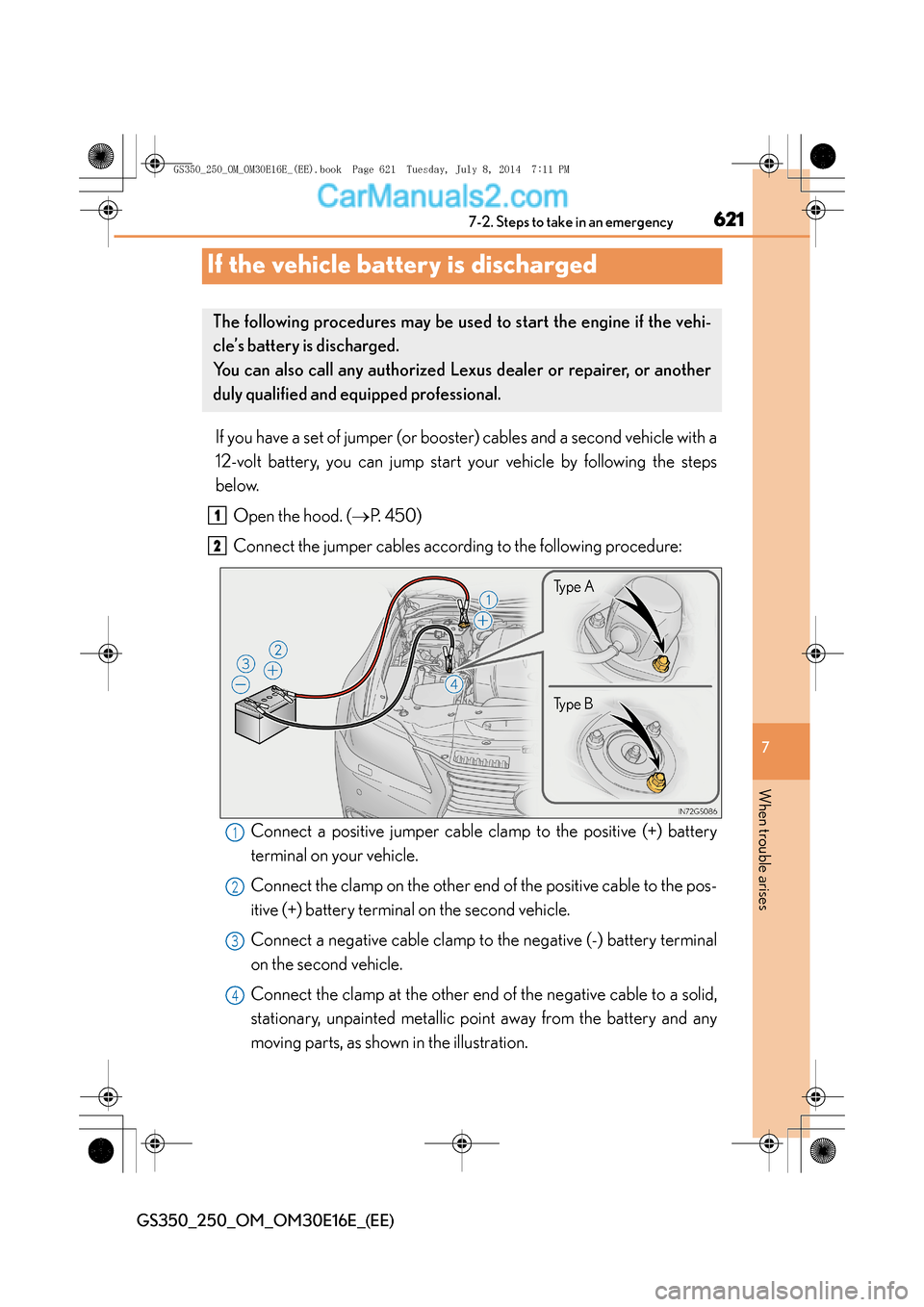
621
7
7-2. Steps to take in an emergency
When trouble arises
GS350_250_OM_OM30E16E_(EE)
If the vehicle battery is discharged
If you have a set of jumper (or booster) cables and a second vehicle with a
12-volt battery, you can jump start your vehicle by following the steps
below.
Open the hood. ( →P. 4 5 0 )
Connect the jumper cables according to the following procedure:
Connect a positive jumper cable clamp to the positive (+) battery
terminal on your vehicle.
Connect the clamp on the other end of the positive cable to the pos-
itive (+) battery terminal on the second vehicle.
Connect a negative cable clamp to the negative (-) battery terminal
on the second vehicle.
Connect the clamp at the other end of the negative cable to a solid,
stationary, unpainted metallic point away from the battery and any
moving parts, as shown in the illustration.
The following procedures may be used to start the engine if the vehi-
cle’s battery is discharged.
You can also call any authorized Lexus dealer or repairer, or another
duly qualified and equipped professional.
1
2
Ty p e A
Ty p e B
1
2
3
4
GS350_250_OM_OM30E16E_(EE).book Page 621 Tuesday, July 8, 201 4 7:11 PM
Page 622 of 688

6227-2. Steps to take in an emergency
GS350_250_OM_OM30E16E_(EE)
Start the engine of the second vehicle. Increase the engine speed
slightly and maintain at that level for approximately 5 minutes to
recharge the battery of your vehicle.
Open and close any of the doors of your vehicle with the engine switch
off.
Maintain the engine speed of the second vehicle and start the engine of
your vehicle by turning the engine switch to IGNITION ON mode.
Once the vehicle’s engine has started, remove the jumper cables in the
exact reverse order from which they were connected.
Once the engine starts, have the vehicle inspected at any authorized
Lexus dealer or repairer, or another duly qualified and equipped profes-
sional as soon as possible.
■Starting the engine when the battery is discharged
The engine cannot be started by push-starting.
■To prevent battery discharge
●Turn off the headlights and the audio system while the engine is off.
●Turn off any unnecessary electrical components when the vehicle is running at a
low speed for an extended period, such as in heavy traffic.
■Charging the battery
The electricity stored in the battery will discharge gradually even when the vehicle is
not in use, due to natural discharge and the draining effects of certain electrical
appliances. If the vehicle is left for a long time, the battery may discharge, and the
engine may be unable to start. (The battery recharges automatically during driving.)
3
4
5
6
GS350_250_OM_OM30E16E_(EE).book Page 622 Tuesday, July 8, 201 4 7:11 PM
Page 623 of 688
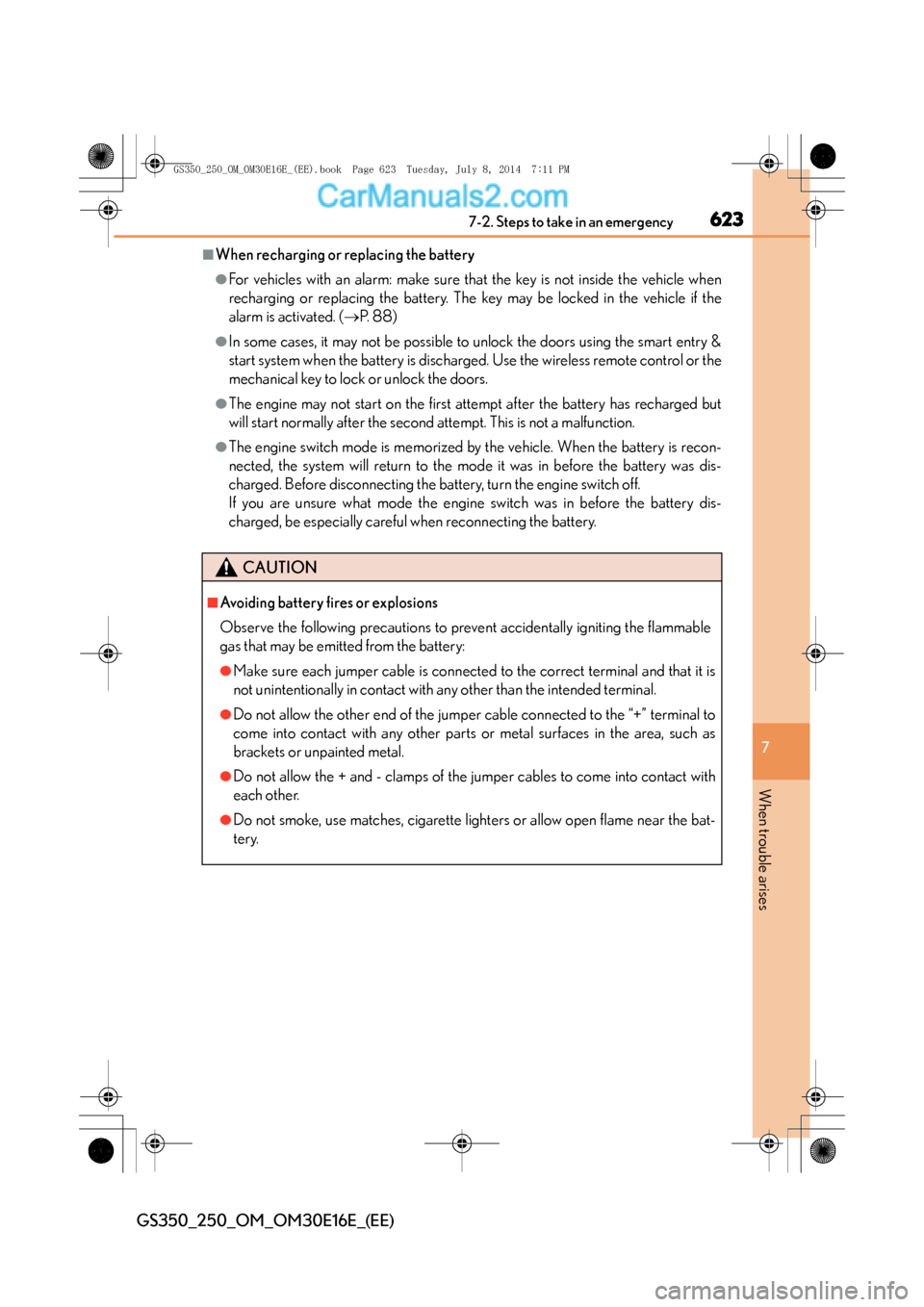
6237-2. Steps to take in an emergency
7
When trouble arises
GS350_250_OM_OM30E16E_(EE)
■When recharging or replacing the battery
●For vehicles with an alarm: make sure that the key is not inside the vehicle when
recharging or replacing the battery. The key may be locked in the vehicle if the
alarm is activated. (→P. 88)
●In some cases, it may not be possible to unlock the doors using the smart entry &
start system when the battery is discharged. Use the wireless remote control or the
mechanical key to lock or unlock the doors.
●The engine may not start on the first attempt after the battery has recharged but
will start normally after the second attempt. This is not a malfunction.
●The engine switch mode is memorized by the vehicle. When the battery is recon-
nected, the system will return to the mode it was in before the battery was dis-
charged. Before disconnecting the battery, turn the engine switch off.
If you are unsure what mode the engine switch was in before the battery dis-
charged, be especially careful when reconnecting the battery.
CAUTION
■Avoiding battery fires or explosions
Observe the following precautions to prevent accidentally igniting the flammable
gas that may be emitted from the battery:
●Make sure each jumper cable is connected to the correct terminal and that it is
not unintentionally in contact with any other than the intended terminal.
●Do not allow the other end of the jumper cable connected to the “+” terminal to
come into contact with any other parts or metal surfaces in the area, such as
brackets or unpainted metal.
●Do not allow the + and - clamps of the jumper cables to come into contact with
each other.
●Do not smoke, use matches, cigarette lighters or allow open flame near the bat-
tery.
GS350_250_OM_OM30E16E_(EE).book Page 623 Tuesday, July 8, 201 4 7:11 PM
Page 624 of 688
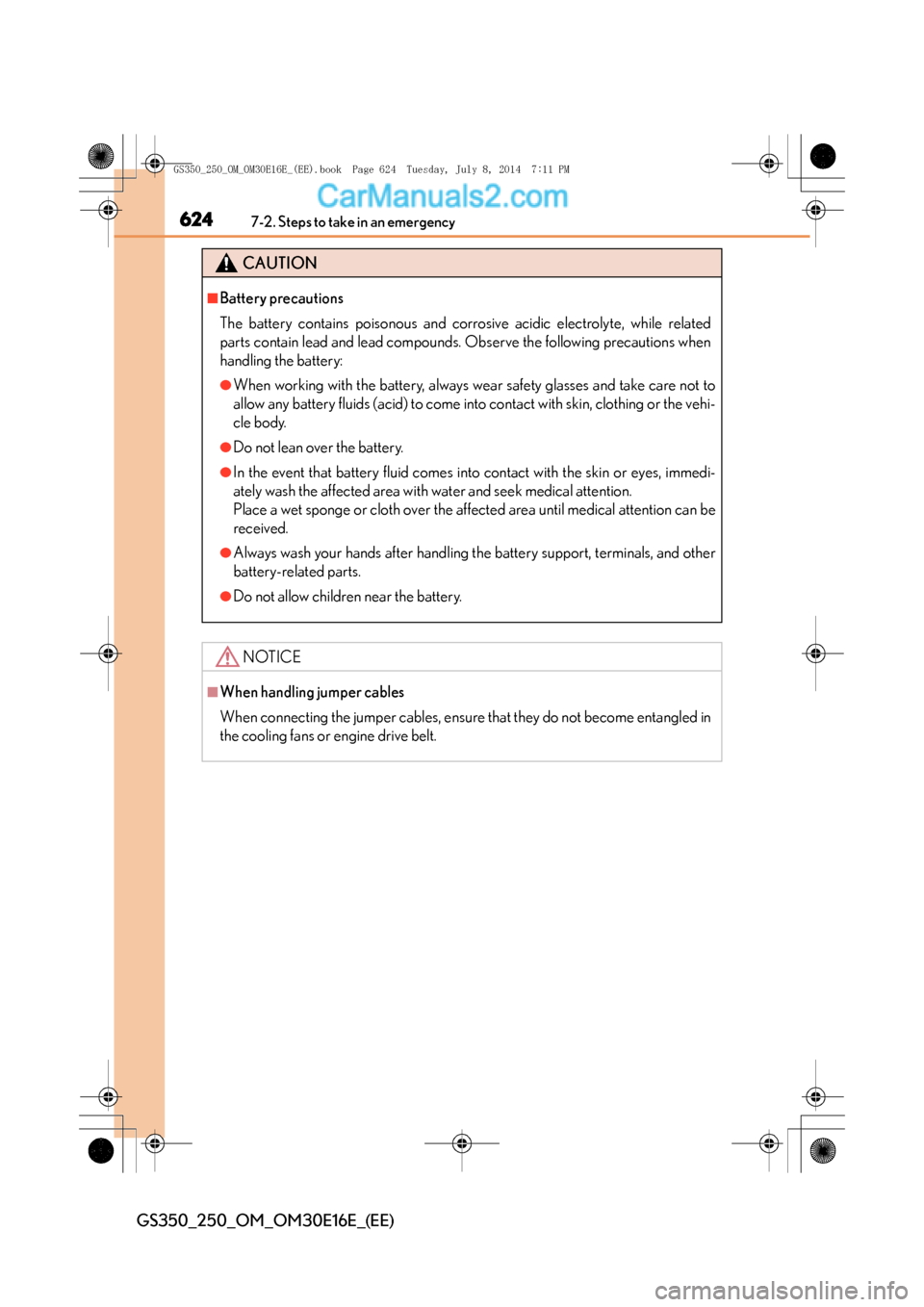
6247-2. Steps to take in an emergency
GS350_250_OM_OM30E16E_(EE)
CAUTION
■Battery precautions
The battery contains poisonous and corrosive acidic electrolyte, while related
parts contain lead and lead compounds. Observe the following precautions when
handling the battery:
●When working with the battery, always wear safety glasses and take care not to
allow any battery fluids (acid) to come into contact with skin, clothing or the vehi-
cle body.
●Do not lean over the battery.
●In the event that battery fluid comes into contact with the skin or eyes, immedi-
ately wash the affected area with water and seek medical attention.
Place a wet sponge or cloth over the affected area until medical attention can be
received.
●Always wash your hands after handling the battery support, terminals, and other
battery-related parts.
●Do not allow children near the battery.
NOTICE
■When handling jumper cables
When connecting the jumper cables, ensure that they do not become entangled in
the cooling fans or engine drive belt.
GS350_250_OM_OM30E16E_(EE).book Page 624 Tuesday, July 8, 2014 7:11 PM
Page 625 of 688
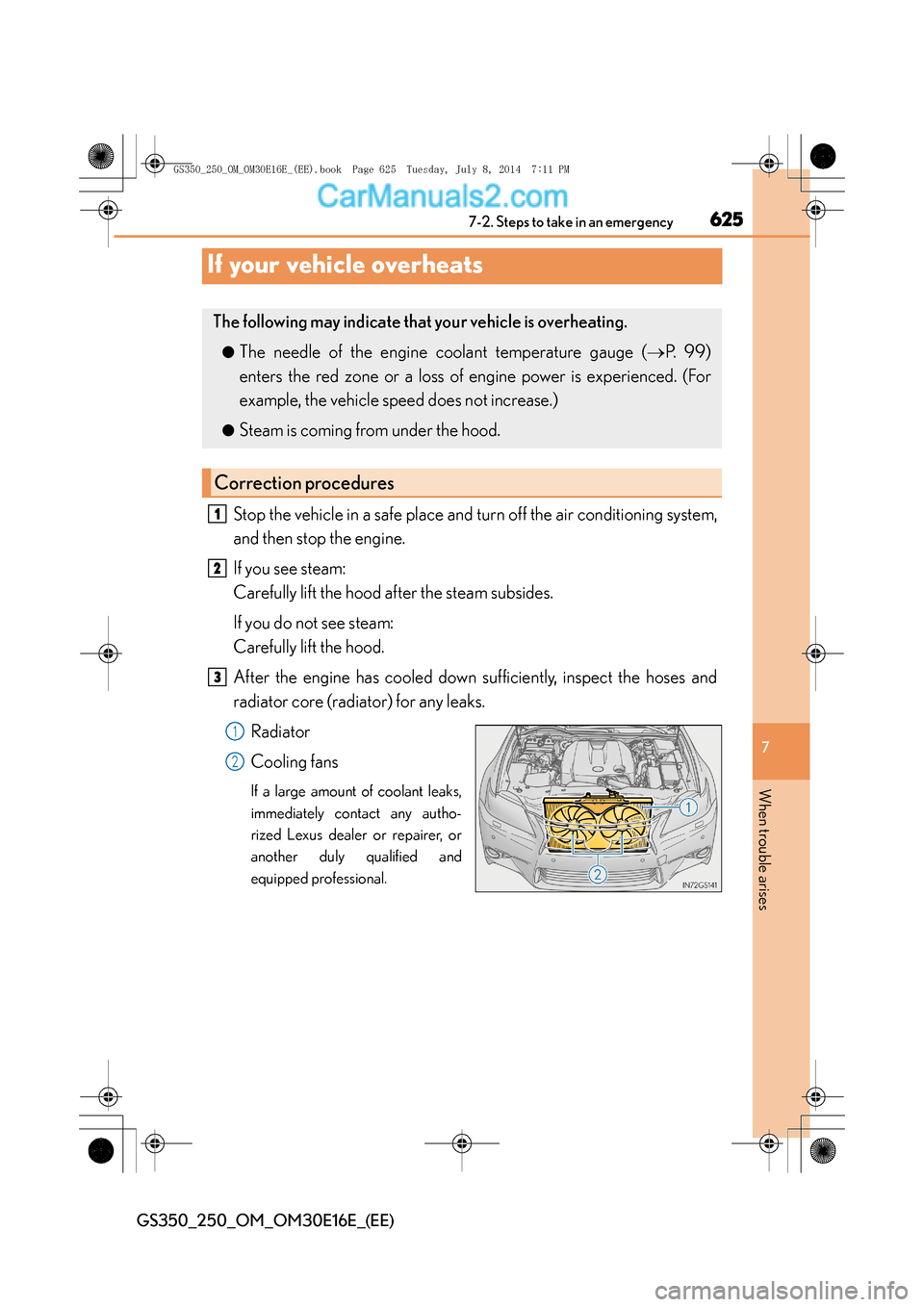
625
7
7-2. Steps to take in an emergency
When trouble arises
GS350_250_OM_OM30E16E_(EE)
If your vehicle overheats
Stop the vehicle in a safe place and turn off the air conditioning system,
and then stop the engine.
If you see steam:
Carefully lift the hood after the steam subsides.
If you do not see steam:
Carefully lift the hood.
After the engine has cooled down sufficiently, inspect the hoses and
radiator core (radiator) for any leaks.
Radiator
Cooling fans
If a large amount of coolant leaks,
immediately contact any autho-
rized Lexus dealer or repairer, or
another duly qualified and
equipped professional.
The following may indicate that your vehicle is overheating.
●The needle of the engine coolant temperature gauge ( →P. 99)
enters the red zone or a loss of engine power is experienced. (For
example, the vehicle speed does not increase.)
●Steam is coming from under the hood.
Correction procedures
1
2
3
1
2
GS350_250_OM_OM30E16E_(EE).book Page 625 Tuesday, July 8, 201 4 7:11 PM
Page 626 of 688
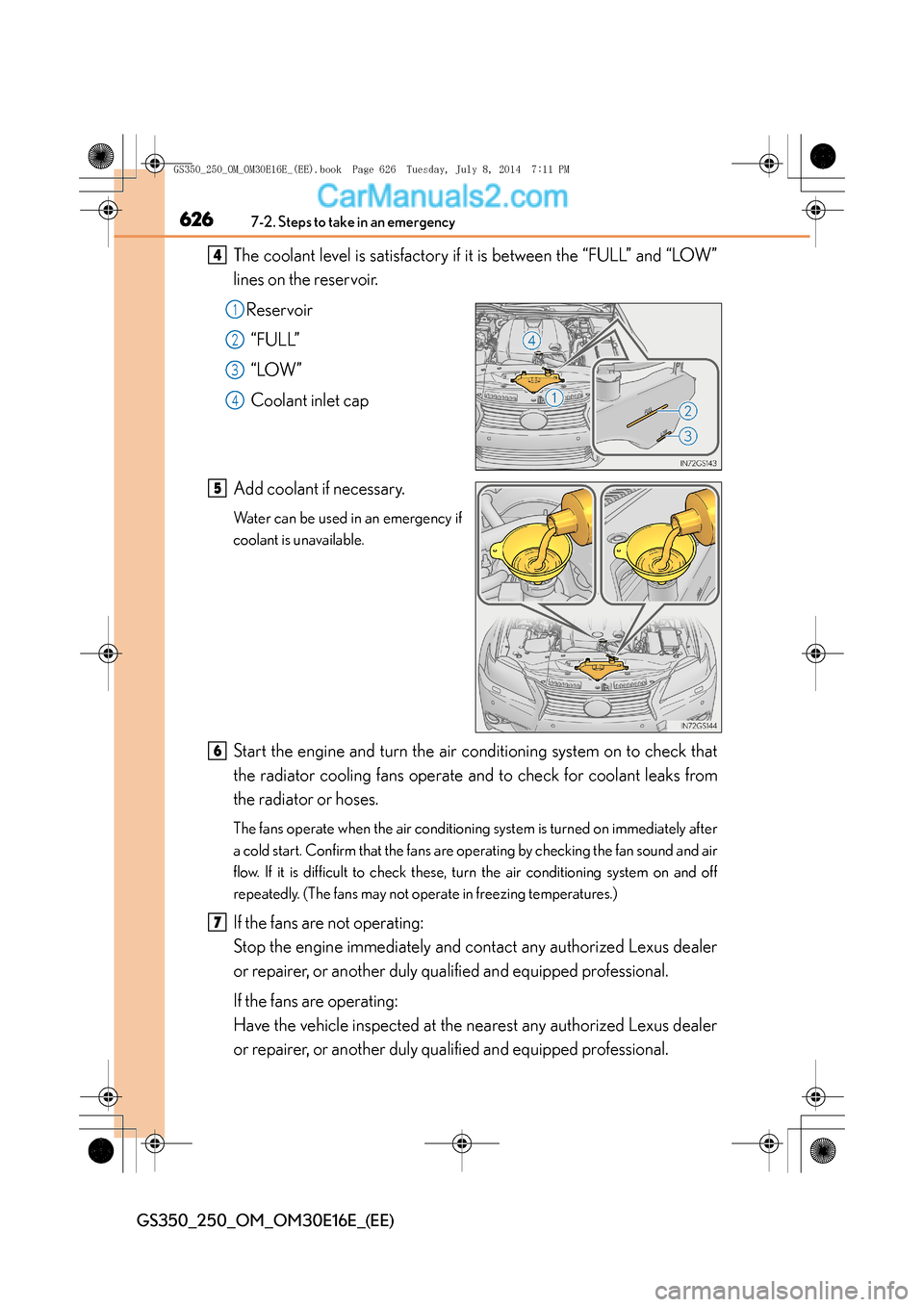
6267-2. Steps to take in an emergency
GS350_250_OM_OM30E16E_(EE)
The coolant level is satisfactory if it is between the “FULL” and “LOW”
lines on the reservoir.Reservoir“FULL”
“LOW”
Coolant inlet cap
Add coolant if necessary.
Water can be used in an emergency if
coolant is unavailable.
Start the engine and turn the air co nditioning system on to check that
the radiator cooling fans operate and to check for coolant leaks from
the radiator or hoses.
The fans operate when the air conditioning system is turned on immediately after
a cold start. Confirm that the fans are operating by checking the fan sound and air
flow. If it is difficult to check these, turn the air conditioning system on and off
repeatedly. (The fans may not operate in freezing temperatures.)
If the fans are not operating:
Stop the engine immediately and contact any authorized Lexus dealer
or repairer, or another duly qualified and equipped professional.
If the fans are operating:
Have the vehicle inspected at the nearest any authorized Lexus dealer
or repairer, or another duly qualified and equipped professional.
4
1
2
3
4
5
6
7
GS350_250_OM_OM30E16E_(EE).book Page 626 Tuesday, July 8, 201 4 7:11 PM
Page 627 of 688
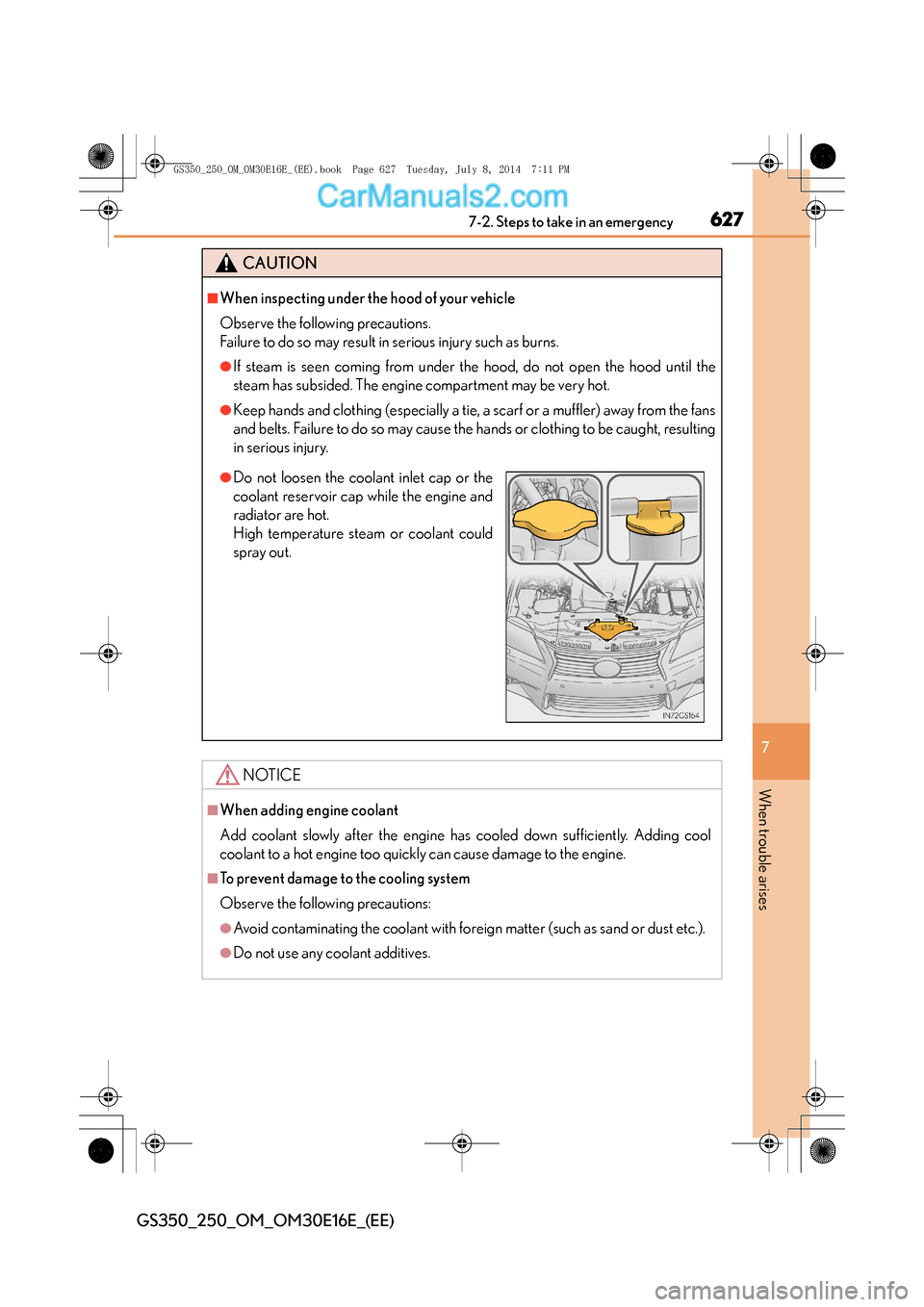
6277-2. Steps to take in an emergency
7
When trouble arises
GS350_250_OM_OM30E16E_(EE)
CAUTION
■When inspecting under the hood of your vehicle
Observe the following precautions.
Failure to do so may result in serious injury such as burns.
●If steam is seen coming from under the hood, do not open the hood until the
steam has subsided. The engine compartment may be very hot.
●Keep hands and clothing (especially a tie, a scarf or a muffler) away from the fans
and belts. Failure to do so may cause the hands or clothing to be caught, resulting
in serious injury.
NOTICE
■When adding engine coolant
Add coolant slowly after the engine has cooled down sufficiently. Adding cool
coolant to a hot engine too quickly can cause damage to the engine.
■To prevent damage to the cooling system
Observe the following precautions:
●Avoid contaminating the coolant with foreign matter (such as sand or dust etc.).
●Do not use any coolant additives.
●Do not loosen the coolant inlet cap or the
coolant reservoir cap while the engine and
radiator are hot.
High temperature steam or coolant could
spray out.
GS350_250_OM_OM30E16E_(EE).book Page 627 Tuesday, July 8, 2014 7:11 PM
Page 628 of 688
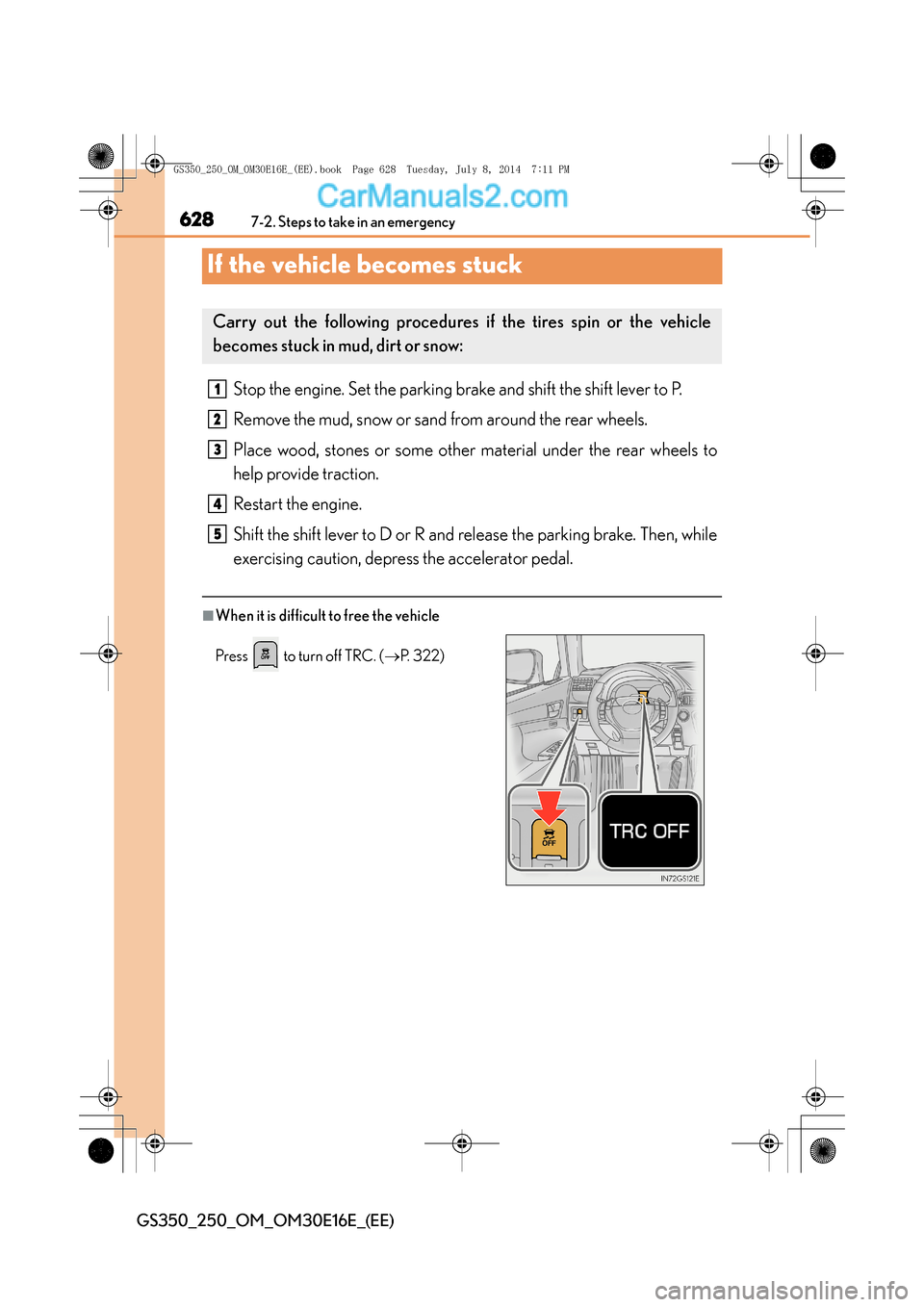
6287-2. Steps to take in an emergency
GS350_250_OM_OM30E16E_(EE)
If the vehicle becomes stuck
Stop the engine. Set the parking brake and shift the shift lever to P.
Remove the mud, snow or sand from around the rear wheels.
Place wood, stones or some other material under the rear wheels to
help provide traction.
Restart the engine.
Shift the shift lever to D or R and release the parking brake. Then, while
exercising caution, depress the accelerator pedal.
■When it is difficult to free the vehicle
Carry out the following procedures if the tires spin or the vehicle
becomes stuck in mu d, dirt or snow:
Press to turn off TRC. ( →P. 3 2 2 )
1
2
3
4
5
GS350_250_OM_OM30E16E_(EE).book Page 628 Tuesday, July 8, 201 4 7:11 PM
Page 629 of 688
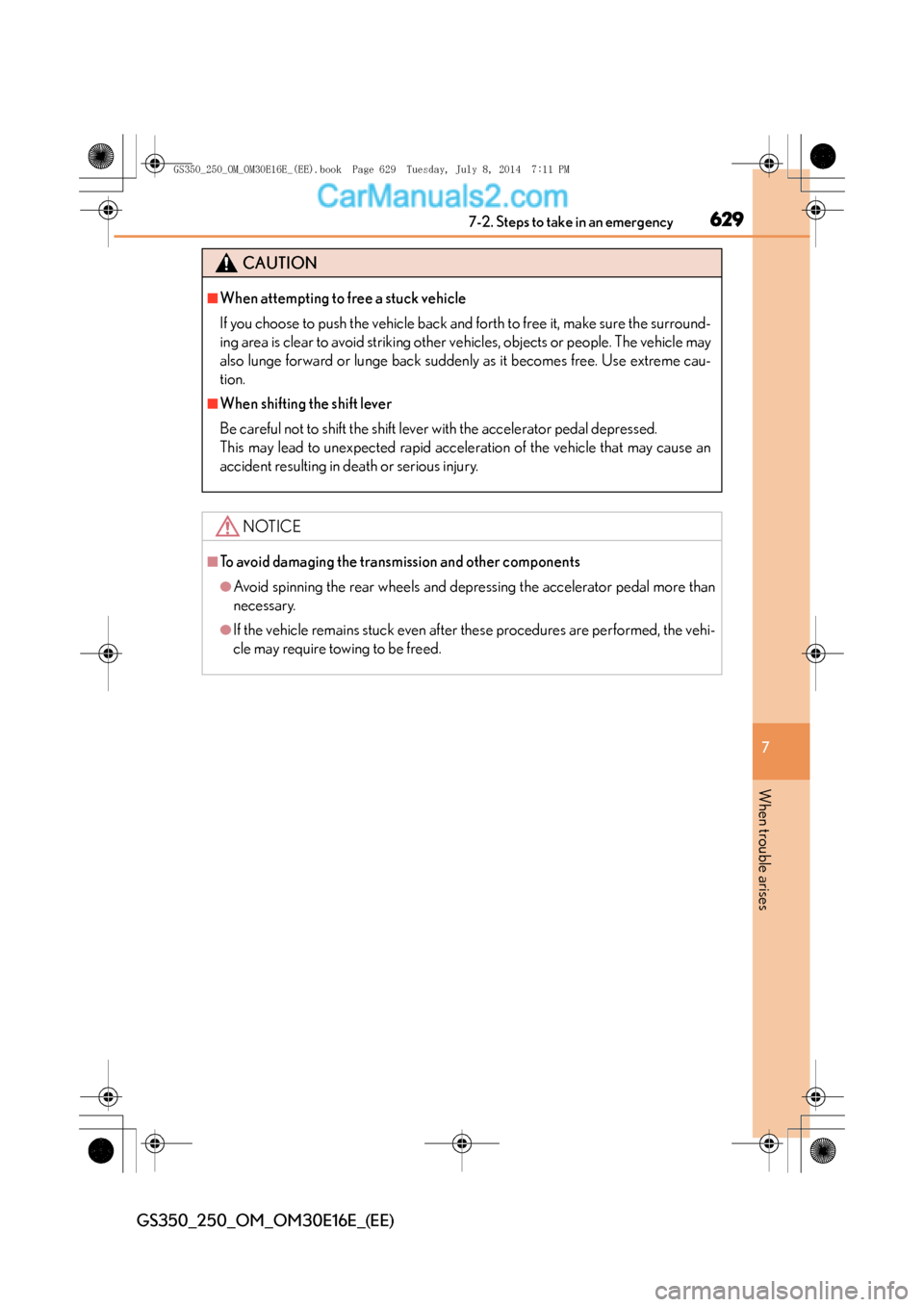
6297-2. Steps to take in an emergency
7
When trouble arises
GS350_250_OM_OM30E16E_(EE)
CAUTION
■When attempting to free a stuck vehicle
If you choose to push the vehicle back and forth to free it, make sure the surround-
ing area is clear to avoid striking other vehicles, objects or people. The vehicle may
also lunge forward or lunge back suddenly as it becomes free. Use extreme cau-
tion.
■When shifting the shift lever
Be careful not to shift the shift lever with the accelerator pedal depressed.
This may lead to unexpected rapid acceleration of the vehicle that may cause an
accident resulting in death or serious injury.
NOTICE
■To avoid damaging the transmission and other components
●Avoid spinning the rear wheels and depressing the accelerator pedal more than
necessary.
●If the vehicle remains stuck even after these procedures are performed, the vehi-
cle may require towing to be freed.
GS350_250_OM_OM30E16E_(EE).book Page 629 Tuesday, July 8, 2014 7:11 PM
Page 630 of 688
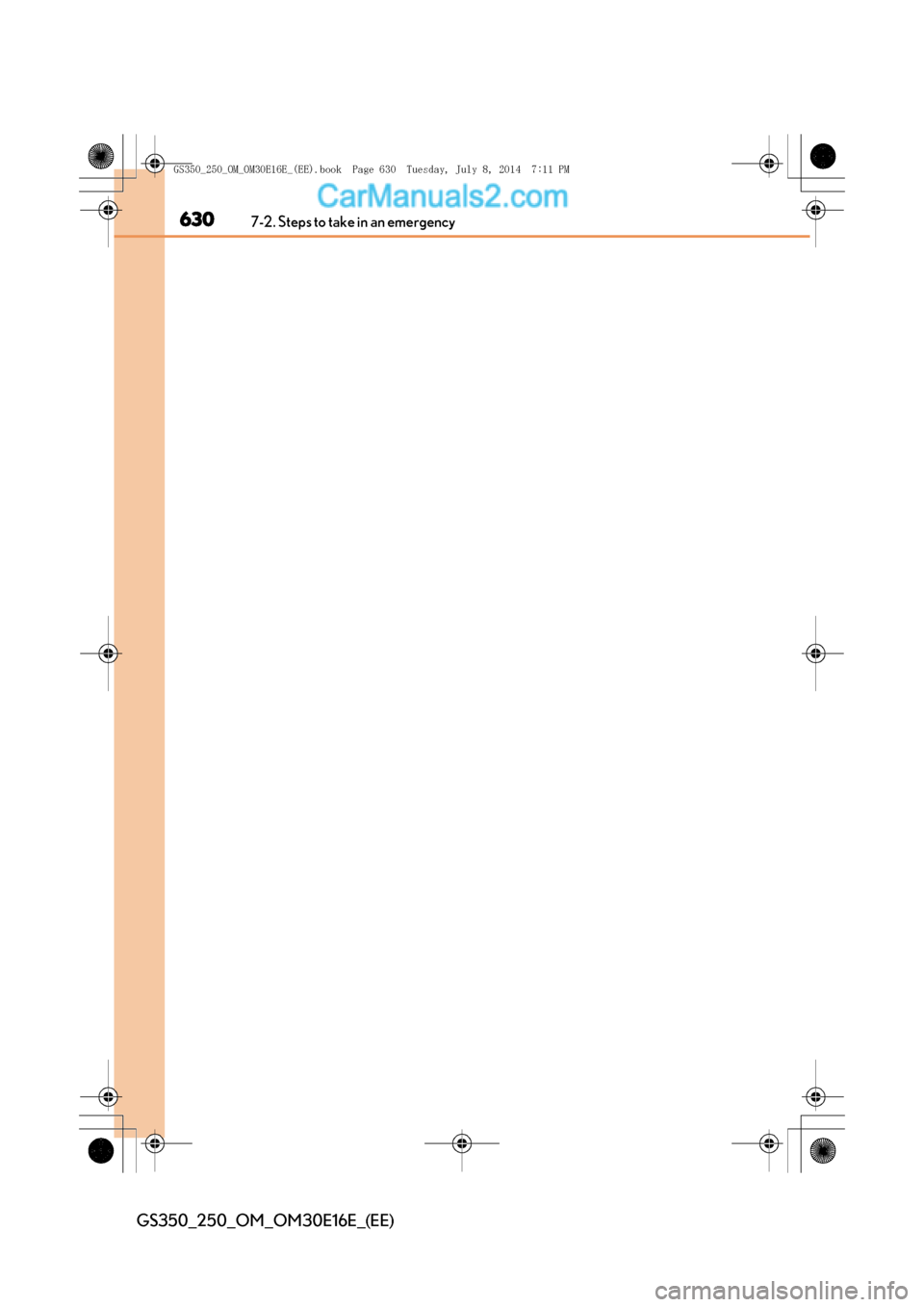
6307-2. Steps to take in an emergency
GS350_250_OM_OM30E16E_(EE)
GS350_250_OM_OM30E16E_(EE).book Page 630 Tuesday, July 8, 2014 7:11 PM